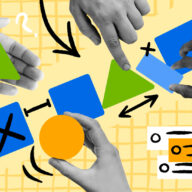Water-cooler chats, casual Fridays, and whiteboard brainstorming sessions. Do these sound like relics of a bygone era?
How we experience work has radically changed. For many, the days of in-person meetings and cubicle chit-chat are a distant memory—and yet employee experience is no less important. In fact, it’s more important than ever. But how do employers create it when they rarely see their team face to face?
Well, it comes down to the virtual environments we work in—our remote work tools. Today, we’ll discuss what employee experience is, why it matters, and how our tools create it in a remote-first world.
What Is Employee Experience?
Obviously, every single employee is having an experience—it’s an inevitable part of working together. We’re constantly interacting with our employer, virtually or not, and employee experience is the cumulative impact of those interactions.
It’s what those experiences mean to us and how they make us feel, for good or bad. Feeling appreciated, fulfilled, stressed, or burnt out could all be facets of an employee’s experience.
Companies are used to paying careful attention to customer experience. But now, they’re realizing that employee experience is equally important—perhaps more important than ever.
Why Does Employee Experience Matter?
Employee experience is about doing the right thing. It’s about treating people well, and creating safe, comfortable, and productive workplaces.
But it also improves metrics like engagement, retention, and turnover. Basically, when people have a better experience, they put in more effort, do better work, and stay with their companies longer. Who would have guessed?
Today, the remote work revolution means workers have more options than ever. Along with widespread labor shortages, it takes more effort than ever for companies to keep their people. If they can’t provide their best workers with a good workplace experience, they’ll lose talent and productivity will suffer—all of which will be reflected in their bottom line.
Remote Work And Employee Experience
Before COVID-19, employee experience revolved around the physical work environment, and in-person interactions with leaders, managers, and colleagues. Today, those aspects still matter, but many organizations have much less control over employees’ work environment, and much less (if any) face-to-face connection.
In 2019, only 13% of employees were fully satisfied with their experience, and just 24% of organizations were actively focused on shaping it. Today, that lack of focus has changed. 92% of HR leaders cited employee experience as a top priority in 2021.
Creating great employee experience has never been easy, and it’s gotten more complex than ever post-COVID-19. The pandemic, and its accompanying workforce disruptions, were felt strongly at many organizations. 40% reported a decline in engagement, and 37% said their culture was negatively impacted.
Today, employers need to create a good employee experience with a radically different toolkit—and many are learning to do so completely on the fly. That’s why it’s so important to be intentional about choosing the right tools for remote work. If where we’re physically working from no longer feels as important, these tools are the difference between stressful, inefficient processes and a daily flow that feels simple, intuitive, and fosters connection.
A Culture Of Communication
Frequent, honest, and open communication—at all levels of a company—is the foundation of good employee experience. In a remote, hybrid, or on-premise model, communication is everything. But unfortunately, this isn’t yet reality. According to research from Gartner, 82% of employees feel their work environment lacks fairness.
Here are a few ways to foster a transparent culture and create workplaces that feel equitable, comfortable, and safe:
- Sharing information equally with all employees to keep everyone informed and empowered
- Listening to employees, through regular 1-to-1s and surveys, and showing them their feedback is actually acted upon
- Facilitating communication between customers and employees, for example passing on positive customer reviews
Translating these values into a remote or distributed context is possible—it just takes a little technology magic. Let’s break down what that looks like.
Workflow Documentation
When teams aren’t physically together in an office, sharing knowledge isn’t as simple as just asking a colleague ‘how do we archive those invoices again?’
That’s why remote teams need to use technology to document how they do things, and make those processes easily accessible to everyone. That creates transparency, helps everyone work more efficiently, and equips everyone with the tools they need to do their job.
Well-documented, accessible workflows will make your company more adaptable, resilient, and efficient. In a remote-first world, employers need software to do this. Luckily, many project-management tools are a perfect fit. Trello and Confluence are two great options;.
Workflow documentation means knowing how to archive those invoices even after Susan from finance has left, and getting her replacement up to speed in a couple of hours. It can also help us work better, because your team can look at their processes objectively and analyze what areas might need to be improved.
Tool Consolidation
Remote work means a constant need for video-conferencing, instant-messaging, real-time and asynchronous collaboration, and access to key information.
Bringing as many of these functions as possible into a single platform saves time and headaches for everyone. Instead of juggling multiple tools for all the above functions, consolidation puts the focus back where it should be—the task at hand!
That’s why tool consolidation is one of the biggest remote work trends for 2022. And it doesn’t even require you to abandon all the tools you already rely on! Thanks to integration and automation, many different tools can work together effortlessly.
7 Tools To Create Great Employee Experience
Trello
Trello connects remote teams through every stage of their experience, from planning to project management to ongoing communication. Trello’s Kanban board-style organization keeps important information where it’s easy to find, all the time.
Google Drive
Companies all over the world rely on Google’s cloud storage platform. Google Drive is a centralized online destination for all the files and content it takes to get work done, and it’s easy to organize them into folders and sub-folders.
Slack
Slack’s lightning-fast messaging is the perfect to way escape from the stressful time-suck of constant email. Organize chats into channels by subject, and add only relevant team members to each.
15Five
Performance reviews and evaluations are a big part of keeping your team on track. But what do they look like in a remote-first landscape? 15five’s data-driven, user-friendly solution elevates performance management, coaching managers on how to bring out the best in their teams.
Jira
Jira is the king of project management tools for agile software teams. This tool gets every user on the same page and cooperating to plan, track, release and report on every development project.
Confluence
Like Trello, Confluence is all about collaboration. But Confluence is a virtual space where all that work and cooperation actually happens, while Trello is geared to tracking how it’s moving forwards. Confluence also comes with a library of ready-to-use templates for disciplines like project management, IT, software development, and sales.
Experience Over Everything
Employee experience is inherently human, personal, and subjective. That’s why it might feel counterintuitive to create it in a remote-work environment.
Honesty, fairness, and open access to information make employees happier at work—that hasn’t changed in our remote-first world. In our new working landscape, we’re still pursuing the same timeless values, we just have the tools to do so in a new way.







































